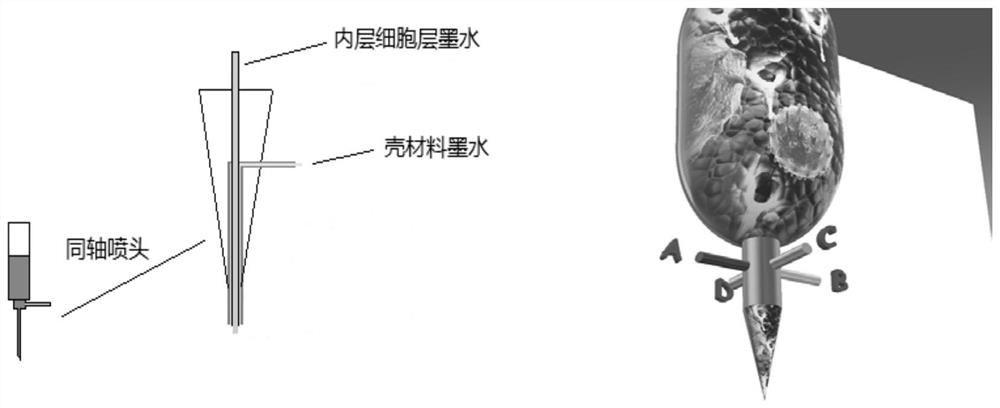A 3D printing bio-ink for rapid repair of spinal injury blood vessels and its preparation method
A 3D printing, spinal injury technology, applied in the field of biological 3D printing, can solve problems such as the poor application of spinal injury blood vessel repair, the difficulty of taking into account the mechanical strength and cell growth environment, cell density, and the uncontrollable space of species, etc. Conducive to growth and reproduction, avoiding cell sedimentation, and promoting rapid repair
- Summary
- Abstract
- Description
- Claims
- Application Information
AI Technical Summary
Problems solved by technology
Method used
Image
Examples
Embodiment 1
[0030] (1) Preparation of shell material ink
[0031] Using deionized water as a solvent, magnetically stir 2% gelatin and 5% sodium alginate; add growth factor VEGF50ng / mL and antibacterial and anti-inflammatory drug streptomycin 100μg / mL magnetically stir evenly, and sterilize by ultraviolet light for 12 hours before use.
[0032] (2) Preparation of Inner Cell Layer Ink
[0033] At 37°C, bone marrow mesenchymal stem cells (BMSC) 1×10 6 / mL, vascular endothelial cells 1×10 6 / mL, smooth muscle fibroblasts 1×10 6 / mL, vascular endothelial growth factor (VEGF) 30ng / mL, platelet growth factor (PDGF) 30ng / mL and basophilic fibroblast growth factor (bFGF) 30ng / mL were added to the complete medium DMEM, and mixed evenly.
[0034] (3) Print preparation
[0035] Coaxial nozzles are used to realize simultaneous printing of shell material and inner cells. The printer adopts extrusion printing equipment. The temperature of the shell material of the printer is set at 37°C and the pr...
Embodiment 2
[0037] (1) Preparation of shell material ink
[0038] Using deionized water as a solvent, magnetically stir 6% gelatin and 2% sodium alginate evenly; add growth factor VEGF100ng / mL and antibacterial and anti-inflammatory drug streptomycin 50μg / mL magnetically stir evenly, and sterilize by ultraviolet light for 16h before use.
[0039] (2) Preparation of Inner Cell Layer Ink
[0040] At 37°C, bone marrow mesenchymal stem cells (BMSC) 3×10 6 / mL, vascular endothelial cells 3×10 6 / mL, smooth muscle fibroblasts 3×10 6 / mL, vascular endothelial growth factor (VEGF) 50ng / mL, platelet growth factor (PDGF) 50ng / mL and basophilic fibroblast growth factor (bFGF) 50ng / mL were added to the complete medium DMEM, and mixed evenly.
[0041] (3) Print preparation
[0042] Coaxial nozzles are used to realize the simultaneous printing of shell materials and inner cells. The printer adopts extrusion printing equipment. The temperature of the shell material of the printer is set at 37°C and...
Embodiment 3
[0044] (1) Preparation of shell material ink
[0045] Using deionized water as solvent, magnetically stir 5% gelatin and 2% sodium alginate evenly; add growth factor VEGF60ng / mL and antibacterial and anti-inflammatory drug streptomycin70μg / mL magnetically stir evenly, ultraviolet sterilize for 18h and set aside.
[0046] (2) Preparation of Inner Cell Layer Ink
[0047] At 37°C, bone marrow mesenchymal stem cells (BMSC) 2×10 6 / mL, vascular endothelial cells 2×10 6 / mL, smooth muscle fibroblasts 2×10 6 / mL, vascular endothelial growth factor (VEGF) 100ng / mL, platelet growth factor (PDGF) 100ng / mL and basophilic fibroblast growth factor (bFGF) 100ng / mL were added to the complete medium DMEM and mixed evenly.
[0048] (3) Print preparation
[0049] Coaxial nozzles are used to realize the simultaneous printing of shell materials and inner cells. The printer adopts extrusion printing equipment. The temperature of the shell material of the printer is set at 37°C and the printin...
PUM
 Login to View More
Login to View More Abstract
Description
Claims
Application Information
 Login to View More
Login to View More - R&D
- Intellectual Property
- Life Sciences
- Materials
- Tech Scout
- Unparalleled Data Quality
- Higher Quality Content
- 60% Fewer Hallucinations
Browse by: Latest US Patents, China's latest patents, Technical Efficacy Thesaurus, Application Domain, Technology Topic, Popular Technical Reports.
© 2025 PatSnap. All rights reserved.Legal|Privacy policy|Modern Slavery Act Transparency Statement|Sitemap|About US| Contact US: help@patsnap.com

